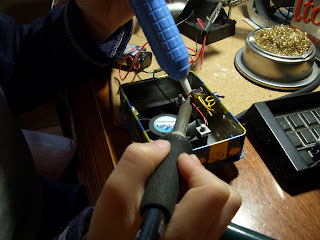Introduction
Last September,
propellerheadgeek (Doug) sent me one of his
Electric Turtle robots to bring to
MakerFaire. He was also kind enough to include one of his laser cut tank kits for me to check out. After an extended delay, here is a review of these two products, which he has
available for sale as kits.
Below you can see both kits assembled, with a marble engraved plaque Doug sent along with his robot. Pretty.
 What You Get
What You Get
Doug's kits come as a set of unassembled laser cut acrylic parts. You provide the specified motors, processor, sensors, etc.
He has four models available at the time of this writing. Three variations of the "turlebot" and one tank kit.
The two models I examined seemed to be very well designed and manufactured. The quality of the materials was very good, with 5mm thick acrylic, parts that align perfectly, and quality etching.
Doug sent his turtlebot already assembled, but I had the pleasure of building the tank kit myself. Assembly for each kit is documented in an Instructable.
Electric Turtle
The Electric Turtle is a two deck round chassis set up for differentially steered wheels. The three kit variations are for the Solarbotics GM-9 motors, continuous rotation servos, or the Tamiya dual motor gearbox. The model pictured here is the Tamiya version.

I liked the quality etching on the parts. In addition to Propellerheadgeek.com branding the top deck of the Electric Turtle is marked with angles from zero to 90 degrees to aid with aligning the sensor on the head servo.

Here's a shot from underneath, showing the Tamiya gearbox, mounting holes, etc. Note the omni caster at the bottom, and the cut-outs for the head servo.

I think the robot Doug sent me was his own, and had probably been around for a while, based on the cracked rubber of the wheels. That is no fault of the chassis, though. All-in-all, it is a very nice kit.
Little Tank
I like the Little Tank robot a lot. I feel like I want to take advantage of the clear body and add something a bit flashy, like some bright blue LEDs. Maybe later.
With the Tamiya gearbox assembed for a high torque gear ratio, this tank can crawl up a 45 degree angle with little problem. I have the robot powered with
3xAA 1.6V NiZn batteries, which are unusual. Fully charged, they are more like 1.8V, and three of them give the Little Tank plenty of power.

This side view gives you an idea of the overall layout. The circuit board on the back is a power regulator board I made. One comment I have on the kit is that if you want to add your own additional board to the kit, you will need to add a deck, place it between decks, or extend it off the existing deck like I did.

Below you can see there is enough width between decks for a 3xAA battery holder with some room to spare. I couldn't get a 4xAA battery holder to fit.

Addendum: I noticed that if you use a standard sized servo instead of the micro servo and adapter, there is actually not enough room for a 3xAA battery holder. However, you can raise the standard servo about 12-13mm with some stand-offs, and then you can still fit the battery pack. See below.
From above, you can see the placement of the deck for the processor (a Picaxe 28 project board, in this case). You can't tell from the picture, but Doug nicely included etched lables on the deck to indicate the mounting holes for Picaxe or Arduino. That's a friendly touch.

OK, last picture. In this one you can see the nice sensor mounting bracket, which will work for a Sharp IR or many of the common sonar sensors. The head servo can be a standard or micro sized, as there is a micro servo adapter included. The hole behind the servo mount is useful for routing wires. I also used it to place a nice sized power switch.
 Kit Assembly
Kit Assembly
I didn't assemble the Electric Turtle myself, so I can't comment much on it. However, Doug provides this nice set of assembly instructions for the
Electric Turtle Robot on Instructables.
I did put together the Little Tank kit, following the assembly instructions for the
'Little Tank' Robot Arduino/Picaxe/Tamiya Platform on Instructables.
The instructions were pretty good, though I ran into a bit of trouble on
Step 7. You have to assemble the parts in the right order, or you'll wind up taking them apart and trying again. I commented on the Instructable with a suggested order of assembly.
Overall, I give the kit assembly a thumbs up!
Results
Nice quality, good design, easy assembly, good price!
Where to Get One
Get 'em at
PropellerHeadGeek.com. I didn't order one through the website, since Doug sent me the stuff directly. However, the site accepts PayPal and he has reasonable shipping terms. The prices for the kits are $18 for the Electic Turtle varients, and $21 for Little Tank, which I think is very good.
I also saw customers write in with positive reviews for the quality of his products and for his service.












